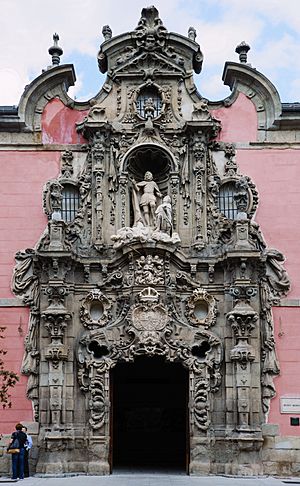Pedro de Ribera facts for kids
Pedro de Ribera (born August 4, 1681, died 1742) was a famous Spanish architect. He lived and worked in Madrid during the early 1700s. He is known for designing many important buildings, bridges, and fountains in the city.
Pedro de Ribera's Life
Pedro de Ribera worked almost only in Madrid. This was during the first half of the 18th century. He learned from José Benito de Churriguera. Churriguera was the creator of the Churrigueresque style. This style is a very fancy and detailed type of Baroque architecture.
Ribera followed his teacher's style. He became one of the most important architects of the late Baroque period in Spain. He designed many buildings in Madrid, which is the capital of Spain. He created bridges, palaces, large fountains, churches, and other public buildings. Many of these can still be seen today.
Between 1718 and 1719, Ribera got an important job. He became the Lieutenant Major Master of Works and Sources for Madrid. He took over after Teodoro Ardemans passed away. This job made him very well-known. It also gave him an important place at the royal court. This was true even though King Philip V of Spain preferred architects from other countries in the 1720s.
Sadly, many of Ribera's designs were later changed or destroyed. This happened especially in the 18th century. At that time, a new style called Neoclassicism became very popular. Neoclassicism was much simpler than the Baroque style Ribera used. Famous art experts, like Antonio Ponz, did not like Ribera's architectural style.
Pedro de Ribera's Works
Francisco Antonio de Salcedo and Aguirre, who was the Marqués de Vadillo, was a very important person for Ribera. He was a patron. This means he supported Ribera and gave him money for many of his projects.
Here are some of the works Pedro de Ribera designed:
- Paseo Nuevo. Puerta de San Vicente (1726–1727)
- Ermita de Nuestra Señora del Puerto (1716–1718)
- Cuartel del Conde-Duque (Guardias de Corps) (started in 1717)
- Puente de Toledo (1718–1732)
- Iglesia de Nuestra Señora de Montserrat (1720)
- Real Hospicio del Ave María y San Fernando (1721–1726)
- Iglesia de San Cayetano (1722–1737)
- Iglesia de San José (1730)
- Portada de la capilla del antiguo Monte de Piedad de Madrid (1733)
- Real Seminario de Nobles (finished in 1725)
- Fuente de la Mariblanca (1726)
- Puente Verde (1728–1732)
- Puente sobre el Abroñigal (1729–1732)
- Carmelitas Descalzas (1730–1742)
- Monasterio de Uclés (1735)
- Teatro de la Cruz (1743)
- Camino nuevo del Escorial (1737)
- Palacio de Torrecilla (1716–1731)
- Palacio del marqués de Miraflores (1731–1732)
- Palacio de Santoña (1730–1734)
- Palacio de Perales (1732)
- Fuente de la Fama (around 1732)
See also
 In Spanish: Pedro de Ribera para niños
In Spanish: Pedro de Ribera para niños


